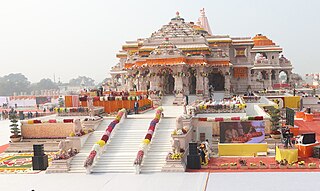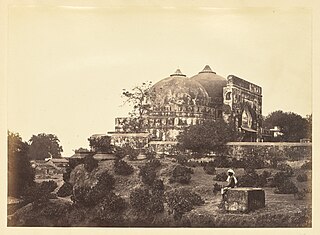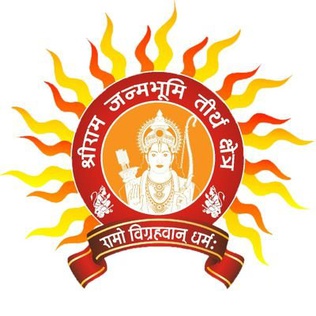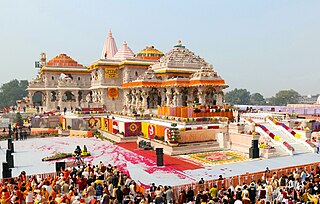Related Research Articles

Ayodhya is a city situated on the banks of the Sarayu river in the Indian state of Uttar Pradesh. It is the administrative headquarters of the Ayodhya district as well as the Ayodhya division of Uttar Pradesh, India.

Babri Masjid was a mosque in Ayodhya, India. It has been claimed to have been built upon the site of Ram Janmabhoomi, the legendary birthplace of Rama, a principal deity of Hinduism. It has been a focus of dispute between the Hindu and Muslim communities since the 19th century. According to the mosque's inscriptions, it was built in 1528–29 by Mir Baqi, a commander of the Mughal emperor Babur. Before the 1940s, the masjid was officially known as "Masjid-i-Janmasthan". The mosque was attacked and demolished by a Hindu nationalist mob in 1992, which ignited communal violence across the Indian subcontinent.
Ram Janmabhoomi is the site that, according to Hindu religious beliefs, is the birthplace of Rama, the seventh avatar of the Hindu deity Vishnu. The Ramayana states that the location of Rama's birthplace is on the banks of the Sarayu river in a city called "Ayodhya". Modern-day Ayodhya is in the north Indian state of Uttar Pradesh. It is contested whether the Ayodhya mentioned in the Ramayana is the same as the modern city.
The Liberhan Commission was a long-running inquiry commissioned by the Government of India to investigate the destruction of the disputed structure Babri Masjid in Ayodhya in 1992. Led by retired High Court Judge M. S. Liberhan, it was formed on 16 December 1992 by an order of the Indian Home Union Ministry after the demolition of the Babri Masjid in Ayodhya on 6 December and the subsequent riots there. The commission was originally mandated to submit its report within three months. Extensions were given 48 times, and after a delay of 17 years, the one-man commission submitted the report to Prime Minister Manmohan Singh on 30 June 2009. In November 2009, a day after a newspaper published the allegedly leaked contents of the report, the report was tabled in Parliament by the Home Minister P. Chidambaram.
The archaeology of Ayodhya concerns the excavations and findings in the Indian city of Ayodhya in the state of Uttar Pradesh, much of which surrounds the Babri Mosque location.

The Ayodhya dispute is a political, historical, and socio-religious debate in India, centred on a plot of land in the city of Ayodhya, Uttar Pradesh. The issues revolve around the control of a site regarded since at least the 18th century among many Hindus to be the birthplace of their deity Rama, the history and location of the Babri Masjid mosque at the site, and whether a previous Hindu temple was demolished or modified to create the mosque.
Kishore Kunal is a former officer of the Indian Police Service from the state of Bihar, India. During his police career, he was appointed as the Officer on Special Duty (Ayodhya) by the prime minister V. P. Singh to mediate between the Vishwa Hindu Parishad and the Babri Masjid Action Committee on the Ayodhya dispute. He continued to serve in this position during the premierships of Chandra Sekhar and P. V. Narasimha Rao.

The demolition of the Babri Masjid was carried out on 6 December 1992 by a large group of activists of the Vishva Hindu Parishad and allied organisations. The 16th-century Babri Masjid in the city of Ayodhya, in Uttar Pradesh, India, had been the subject of a lengthy socio-political dispute, and was targeted after a political rally organised by Hindu nationalist organisations turned violent.
The Akhil Bharatiya Akhara ParishadABAP, one of the organizations of Hindu sants (saints) and sadhus (ascetics) in India. The ABAP is composed of 14 akharas, or organisations of Hindu sants and sadhus. Nirmohi Akhara and Shri Dattatreya Akhara are two of the prominent akharas which are part of it.
Ram Janmabhoomi Nyas is an organisation which was formed as a trust to promote and oversee the construction of a temple in Ayodhya, India at the Ram Janmabhoomi, the reputed site of the birth of the Hindu deity Rama. The Nyas was formed by members of the Vishva Hindu Parishad.

The Ram Rath Yatra was a political and religious rally that lasted from September to October 1990. It was organised by the Bharatiya Janata Party (BJP) and its Hindu nationalist affiliates, and led by the then-president of the BJP, L. K. Advani. The purpose of the yatra was to support the agitation, led by the Vishwa Hindu Parishad (VHP) and its affiliates in the Sangh Parivar, to erect a temple to the Hindu deity Rama on the site of the Babri Masjid.

Suraj Bhan (1931–2010) was an Indian archaeologist and professor of archaeology. His academic work was said to bear a deep imprint of Marxism. He was also involved with the work of Communist Party of India (Marxist) in Haryana and took particular interest in the People's Science movement.

Ram ke Naam is a 1992 documentary by Indian filmmaker Anand Patwardhan. The film explores the campaign waged by the right-wing Hindu nationalist organisation Vishva Hindu Parishad to build a temple to the Hindu deity Ram at the site of the Babri Masjid in Ayodhya, as well as the communal violence that it triggered. A couple of months after Ram ke Naam was released, activists of the VHP and other Hindu nationalist groups demolished the Babri Masjid in 1992, provoking further violence. The film earned Patwardhan a wide recognition, and received several national and international awards.
Khanda is a big & historical village in Kharkhoda tehsil of Sonipat district in Haryana, India. It is located 2 miles (3.2 km) from Kharkhoda and 7 miles (11 km) from Sonipat. It is a part of the Delhi NCR. Khanda has two Gram Panchayats Khanda Khas & Khanda Alman. Two Sarpanchs elects from the village in every five years. Khanda is the head of 12 villages of Dahiya Khap mainly known as.

The final judgement in the Ayodhya dispute was declared by the Supreme Court of India on 9 November 2019. The Supreme Court ordered the disputed land to be handed over to a trust to build the Ram Janmabhoomi temple. The court also ordered the government to give an alternative 5 acres of land in another place to the Uttar Pradesh Sunni Central Waqf Board for the purpose of building a mosque as a replacement for the demolished Babri Masjid.

Shri Ram Janmabhoomi Teerth Kshetra is a trust set up for the construction and management of Ram Mandir in Ayodhya by the Government of India in February 2020. The trust is composed of 15 trustees.

The Ram Mandir is a partially constructed Hindu temple complex in Ayodhya, Uttar Pradesh, India. Many Hindus believe that it is located at the site of Ram Janmabhoomi, the mythical birthplace of Rama, a principal deity of Hinduism. The temple was inaugurated on 22 January 2024 after a prana pratishtha (consecration) ceremony. On the first day of its opening, following the consecration, the temple received a rush of over half a million visitors, and after a month, the average number of visitors was reported to be "1 to 1.5 lakh on a daily basis".
Baba Lal Das was first ever Mahant of the idols of the deity Rama placed within the Babri Masjid complex in Ayodhya. He was appointed to his position by the Lucknow High Court in 1981. Lal Das was a fierce critic of Rashtriya Swayamsevak Sangh (RSS), Bharatiya Janata Party (BJP) Vishva Hindu Parishad and Bajrang Dal, and he criticized these groups in the 1992 documentary Ram ke Naam.

The Prana pratishtha (consecration) ceremony of the Ram Mandir was held on 22 January 2024, in a traditional sacred ceremony, wherein priests recited mantras invoking the deity Rama. The Prana Pratishtha ceremony, that is considered to bring a presence of divinity, is an essential ritual before the inauguration of a Hindu temple. The ceremony involved the pran pratishtha of the primary temple deity, Ram Lalla, also known as Balak Ram, and subsequent opening of the temple for visitors.

Balak Ram, also known as Ram Lalla, is the primary murti (idol) of the Ram Mandir, a prominent Hindu temple located at Ram Janmabhoomi, the mythical birthplace of the Hindu deity Rama in Ayodhya, India. Balak Rama is housed in the sacred sanctum sanctorum of the Ram Mandir, a traditional Nagara style temple. The murti (idol) was consecrated in an elaborate Prana pratishtha ceremony on January 22, 2024.
References
- 1 2 Who Are the Nirmohi Akhara? Wall Street Journal - 30 September 2010
- ↑ "डॉ. राज सिंह निर्मोही अखाड़े के सलाहकार नियुक्त". Dainik Jagran (in Hindi). Retrieved 23 December 2022.
- ↑ "डॉ राज सिंह निर्मोही अखाड़े के सलाहकार नियुक्त". Hindustan (in Hindi). Retrieved 23 December 2022.
- 1 2 "Disputed site in Ayodhya is Ram's birthplace: High Court". Hindustan Times. 30 September 2010. Archived from the original on 3 October 2010. Retrieved 31 July 2012.
- ↑ "Welcome to Frontline : Vol. 29 :: No. 15". Hinduonnet.com. Archived from the original on 1 January 2003. Retrieved 31 July 2012.
{{cite web}}: CS1 maint: unfit URL (link) - ↑ "Allahabad High Court Judgement summary" (PDF). Elegalix.allanhabadhighcourt.in. pp. 15/17. Retrieved 30 October 2013.
- ↑ "Decision of Hon'ble Special Full Bench hearing Ayodhya Matters". Archived from the original on 1 October 2010. Retrieved 10 November 2011.
- ↑ "Who is Nirmohi Akhara". The Asian Age. 30 September 2010. Retrieved 31 July 2012.